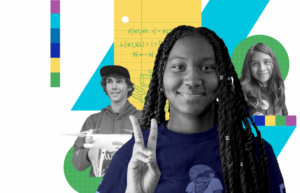The Case For Competency-Based Education

“In the past, education was about teaching people something. Now it is about making sure that individuals develop a reliable compass and the navigation skills to find their own way through an increasingly uncertain, volatile and ambiguous world.” That’s the conclusion of a new OECD book.
In Schooling Redesigned, the OECD makes the case for transformed schools that feature tasks and projects that challenge young people in authentic ways to build design, collaboration, and communication skills that prepare young people for navigating new and complex situations.
The most promising but challenging part of the transformation will be from marking time to demonstrating mastery. For hundreds of years, schools have been organized around age cohorts and lockstep progress based on a compulsory school year and credit hours. The problem is this system doesn’t work for most learners–some students are bored and frustrated and others don’t get what they need and are pushed through the system with big academic gaps that prevent success at higher levels.
A new report outlines some of the reasons our system has been so resilient to change, starting with the fact that it’s hard to measure learning. Local, state, and federal policies that guide student progress, graduation, and college admissions are often based on seat time. And there are a couple hundred years of tradition to overcome.
Show What You Know: The State of Competency-Based Education, written by Getting Smart and published by the XQ Institute, lays out four reasons for change.
1. Quality preparation. Much of the corporate training world has shifted from participation to demonstrated skills in order to improve job readiness. Blended and personalized approaches are more popular with employees and more cost-effective for employers.
As useful as his video tutorials have been, Sal Khan’s big contribution to education may prove to be his advocacy for competency-based learning. His now famous house built on a bad foundation analogy makes the case that passing students on who have only mastered 70 or 80 percent of the material leaves fatal gaps in understanding that are never likely to be closed and leave learners unable to make creative know-how of the skill set. He argues that students should master skills at a high level before moving on to enable skill transference.
2. Learning science. As Harvard’s Todd Rose notes, there is no average; each of us has a “jagged profile.” He and others argue that we should address the individual needs of learners.
“The research on how students learn examines how important it is to meet a student within their zone of proximal development, allow for productive struggle and design progressions effectively – where learning hinges on successful prior learning,” according to iNACOL.
3. Equity. If gap-closing equity is a stated goal, then structures, schedules, and supports can be aimed at struggling learners that need more time and assistance to accelerate their learning (more resources would need to be directed, for example, to schools and teachers serving disadvantaged students). With a focus on equity, CompetencyWorks (a project of iNACOL) suggests that competency-based learning interrupts inequitable practices and promotes high outcomes for all learners. In her keynote speech at the 2019 iNACOL conference, XQ’s Russlynn Ali said that “high schools are the next frontier in the fight for educational equity.”
4. Agency. More than a decade of research suggests that mindset matters in postsecondary and career success. The extent to which a student owns their own learning, often called agency, is key and is represented in new outcome frameworks such as XQ Learner Goals and MyWays from NGLC. Mary Ryerse of Getting Smart reflects, “When students themselves have a sense of who they are, where they are headed and what it will take to get there — both in terms of daily habits and long-term plans — there is a unique sense of purpose and ownership.”
What’s Next?
To disrupt the inertia that has made change so difficult, and to fundamentally rethink what graduates ought to know and be able to do, innovation is required in five dimensions:
- More innovative learning models and networks, particularly for high schools (XQ, NewSchools, and NGLC grantees are a good start);
- Competency-based learning platforms, gradebooks, badge and portfolio systems;
- Quality guidance systems that ensure equity and access;
- Mastery-based transcripts that allow students to more fully share their capabilities with postsecondary institutions and employers;
- State policy that advances a relevant graduate profile, makes room for innovation pilots, and articulates a quality outcome framework (see the CompetencyWorks report Fit for Purpose).
The global shift to competency is underway. It will better enable us to meet students where they are, ensure that they get what they need, and help them tell their unique story. Everyone involved in education has opportunities to help make the transition faster, better and more equitably.
For more see:
- Show What You Know: The Shift to Competency
- Taking the Long View on Competency-Based Education
- CBE Supports at the School, Teacher and Student Levels
This post was originally published on Forbes.
Stay in-the-know with all things edtech and innovations in learning by signing up to receive the weekly Smart Update. This post includes mentions of a Getting Smart partner. For a full list of partners, affiliate organizations and all other disclosures, please see our Partner page.




0 Comments
Leave a Comment
Your email address will not be published. All fields are required.